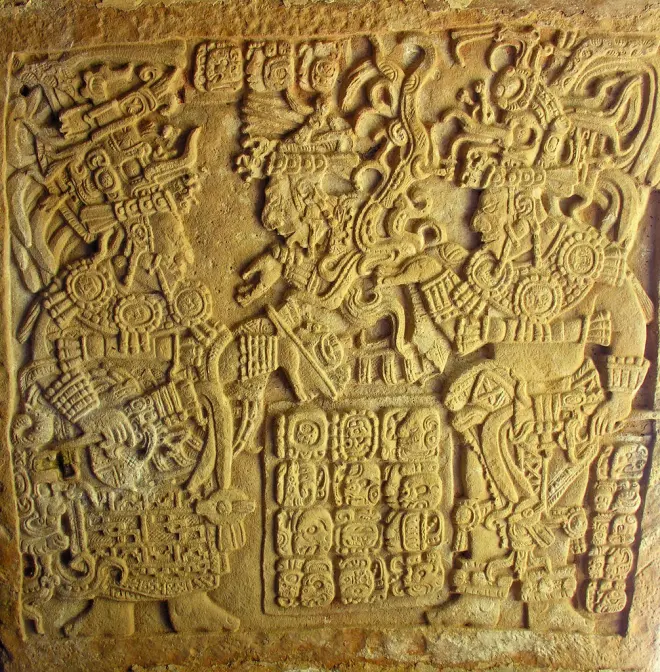【简译】亚斯奇兰(Yaxchilan,发音为 [ʝaʃtʃiˈlan])

Yaxchilan, located on the banks of the Usumacinta River in the Yucatán peninsula of Mexico, was an important Late Classic Maya centre. The Maya dated the founding of their city to 320 CE, but Yaxchilan flourished between c. 580 and c. 800 CE, benefitting from commerce via the Usumacinta River and trading in copal resin and dyes processed from Brazil wood. Remains of stone pilings suggest the site once had a bridge or toll gate. Impressive in both architecture and sculpture, the site displays evidence of warfare before its collapse in the 9th century CE.
亚斯奇兰位于墨西哥尤卡坦半岛的乌苏马辛塔河畔,是玛雅古典晚期的重要中心之一。玛雅人将其城市的建立时间定在公元320年,亚斯奇兰在公元580年至800年之间非常繁荣,这受益于通过乌苏马辛塔河上的商业活动,以及用巴西木材加工的椰壳树脂和染料贸易。残存的石桩表明该遗址曾经有一座桥。该遗址在建筑和雕塑方面都给人留下了深刻的印象,公元9世纪该城崩塌,该遗址向我们展现了这里曾发生战争的痕迹。
Unfortunately, the buildings of Yaxchilan have suffered from damage and erosion by floods over the centuries. However, further from the river are several small hills on the west and east sides upon which platforms and terraces were constructed. Much of the surviving architecture is in the Petén style, as seen at sites such as Tikal, and contact between the two sites is established through royal inter-marriages. In addition, narrow multiple entrances and ornate roof combs remind of Palenque.
不幸的是,几个世纪以来,亚斯奇兰的建筑遭受了洪水的破坏和侵蚀。然而,在离河边更远的地方,有几座小山,人们在这些山上建造了平台和梯田。现存的大部分建筑都是Petén风格,就像在蒂卡尔等遗址看到的那样,两个遗址之间的联系是通过皇室间的通婚建立的。此外,狭窄的多个入口和华丽的屋顶让人想起帕伦克。
One of the most impressive Petén-style buildings is the symmetrical Structure 33, built c. 750 CE, which is approached by a double platform with staircases and whose comb is supported by interior buttressing. The structure was built in honour of the mid-8th century CE Yaxchilan ruler Bird-Jaguar (ruled 752-768 CE) whose likeness appeared in stucco decorations in the centre of the building's roof comb. In front of the building is a carved stalactite which represents a sacred cave. Bird-Jaguar went on to expand Yaxchilan and constructed no fewer than eleven more buildings and 33 monuments.
最令人印象深刻的Petén式建筑之一是对称的33号遗址,该遗址大约建于公元750年,由一个带楼梯的双平台连接,其屋顶由内部支撑物支撑。该建筑是为了纪念公元8世纪中叶的亚克西兰统治者Bird-Jaguar(公元752-768年在位)而建造的,他的肖像出现在建筑屋顶中心的灰泥装饰上。在建筑的前面有一个雕刻的钟乳石,代表着一个神圣的洞穴。Bird-Jaguar继续扩建亚斯奇兰,又建造了不少于11座建筑和33座纪念碑。
Yaxchilan is also noteworthy for its sculpture, both on free standing stelae and on buildings, especially lintels where the scenes can only be seen from directly below. Early figures are depicted from the front and are relatively unremarkable, but from the mid-8th century CE figures are rendered in profile and designs become more dynamic, often framed by Maya glyphs. Stela 11 shows two standing figures in costume on the front, probably signifying the accession of the ruler Bird-Jaguar alongside his father and, in a quite different style, the reverse side again shows Bird-Jaguar, this time represented as the god Chahk, attacking three kneeling victims with his sceptre.
亚斯奇兰的雕塑也值得一提,无论是在独立的石碑上还是在建筑上,特别是在只能从正下方看到场景的门楣上。早期的人物是以正面视角描绘的,相对来说并不引人注目;但从公元8世纪中叶开始,人物的轮廓被描绘出来,设计变得更加生动,雕刻通常由玛雅石刻构成。第11号石碑的正面显示了两个穿着服装的站立人物,可能意味着统治者Bird-Jaguar与他的父亲一起登基,而背面则以一种完全不同的风格再次展示了Bird-Jaguar,这次是代表Chahk神,用他的权杖攻击三个跪着的受害者。
Scenes on limestone lintels, carved in high relief, typically portray rituals such as a worshipper drawing blood from his tongue in the presence of a priest and Bird-Jaguar standing over a kneeling captive. Another vivid scene, from Temple 23, shows a giant double-headed snake creature from the mouths of which emerge a warrior and the war and rain god Tlaloc, who both tower over a kneeling worshipper, identified as Lady Xok', wife of the Yaxchilan ruler Shield-Jaguar (r. 681-742 CE), who sees the monster in a blood-letting induced vision. This scene, as indicated by the glyphs, occurred on 23rd October 681 CE, the accession of Itzamnaaj Bahlam II, 'Shield Jaguar the Great'. Traces of red, greens, and yellows indicate that the panels were once brightly painted. These violent scenes are amongst the earliest to show such graphic episodes of religious life and conquest, although they would later become common in the art of the Toltec and Aztec civilizations.
石灰岩门楣上的场景,以高浮雕的形式,典型地描绘了一些仪式,如一个崇拜者在祭司面前抽出舌头上的血,Bird-Jaguar站在一个跪着的俘虏身上。另一个生动的场景来自第23号神庙,展示了一个巨大的双头蛇形生物,从它的嘴里冒出一个战士和战争与雨神特拉洛克,他们都站在一个跪着的崇拜者身上,被确认为亚克西兰统治者Shield-Jaguar(公元681-742年)的妻子Xok',她在放血的幻觉中看到这个怪物。正如石刻所显示的那样,这一幕发生在公元681年10月23日,即Itzamnaaj Bahlam II "Shield Jaguar大帝"登基的日子。红色、绿色和黄色的痕迹表明,这些画板曾经被涂得很亮。这些暴力场面是最早展示宗教生活和征服的生动场面之一,尽管它们后来在托尔特克和阿兹特克文明的艺术中变得很常见。

参考书目:
Coe, M.D. The Maya. Thames & Hudson, 2011.
Kubler, G. The Art and Architecture of Ancient America, Third Edition. Yale University Press, 1984.
Miller, M.E. The Art of Mesoamerica. Thames & Hudson, 2006.
Nichols, D.L. The Oxford Handbook of Mesoamerican Archaeology. Oxford University Press, 2012.
Phillips, C. The Illustrated Encyclopedia of the Aztec & Maya& Central America - Including The Aztec.. Lorenz Books, 2007.

原文作者:Mark Cartwright
驻意大利的历史作家。他的主要兴趣包括陶瓷、建筑、世界神话和发现所有文明的共同思想。他拥有政治哲学硕士学位,是《世界历史百科全书》的出版总监。
原文网址:https://www.worldhistory.org/Yaxchilan/


